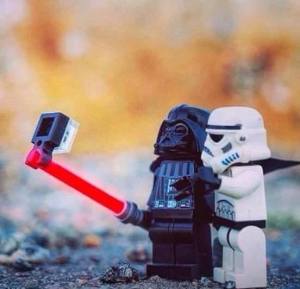McLuhan wrote that the tools shape not only users and their needs, but the entire environment as well. Thus, the automobile has given rise to several industries, and a network of highways and roadside infrastructure, including motels, supermarkets, etc. Arguably, merchandising – the technology of supermarket shelving – was preordained by Ford-T, in the same way that the size of a ballistic missile can be traced back to the width of Roman chariot. The tools determine the environment even when it comes to little details, where the links to the tools are not obvious, but the origin of these links is inescapable.
 I was at an airport once when a young couple walked by. The guy was taking a selfie, holding his camera on a special stick to capture a larger image. Sticks have been used as holders before, but old tripod mounts were used to take pictures of other people. Now, the mount is turned at an angle that makes it possible to take selfies from a distance: that of an extended arm.
I was at an airport once when a young couple walked by. The guy was taking a selfie, holding his camera on a special stick to capture a larger image. Sticks have been used as holders before, but old tripod mounts were used to take pictures of other people. Now, the mount is turned at an angle that makes it possible to take selfies from a distance: that of an extended arm.
This stick extends the arm as perceptibly as a fishing rod, but with one major difference. The selfie stick reverses the application of extension from the object to the subject. A fishing rod extends the arm outward to ensure the operator’s better control over the external world. The selfie stick extends the arm in order to apply an extended function back to the operator. At this point, it occurred to me that, in fact, the entire course of technological development and civilization has all been leading up to the creation of an environment for selfies.
However, the tools that create an environment are, in turn, subject to some outward global logic than that which that describes them. Nothing happens without a reason: even sheep wear sheepskins.
After all, all tools created by man over the course of history serve to gradually improve the ability of humans to copy their own selves through tool-assisted McLuhan body extension; then – through the amputation of functions (such as memory or writing) using external devices. Then (and this is happening already today) – through copying a rendered image (creating an improved person in social media or/ and selfie mania). All this amounts to an ever-accelerating and concentrating practice of copying skills, from cave paintings all the way through the Vitruvian Man.
Eventually, an ultimate copy should appear.
An ultimate copy would be a copy which, like myself, has its own will (See the chapter, The paradox of self-copying). The ultimate copying means extending the personality into the external material, to the point of complete amputation. It is the logical conclusion of McLuhan’s “narcissism.” The race of extensions leads to a set of amputations that results in the complete alienation of self. This is funny: the selfie is the harbinger of the alienation of self.
Well, the time has come to buy a camera stick: an arm extension for taking selfies. Now we extend our arms not with a spear, a fishing pole or a hoe, but with a selfie stick. This telescoping selfie armed arm represents the quintessence of the last 12,000 years that have elapsed since the beginning of the Neolithic Revolution.
Author of Human as media. The emancipation of authorship – available on Amazon
Categories: Augmented reality, Future of journalism, Immersive experience, Media ecology

Leave a comment